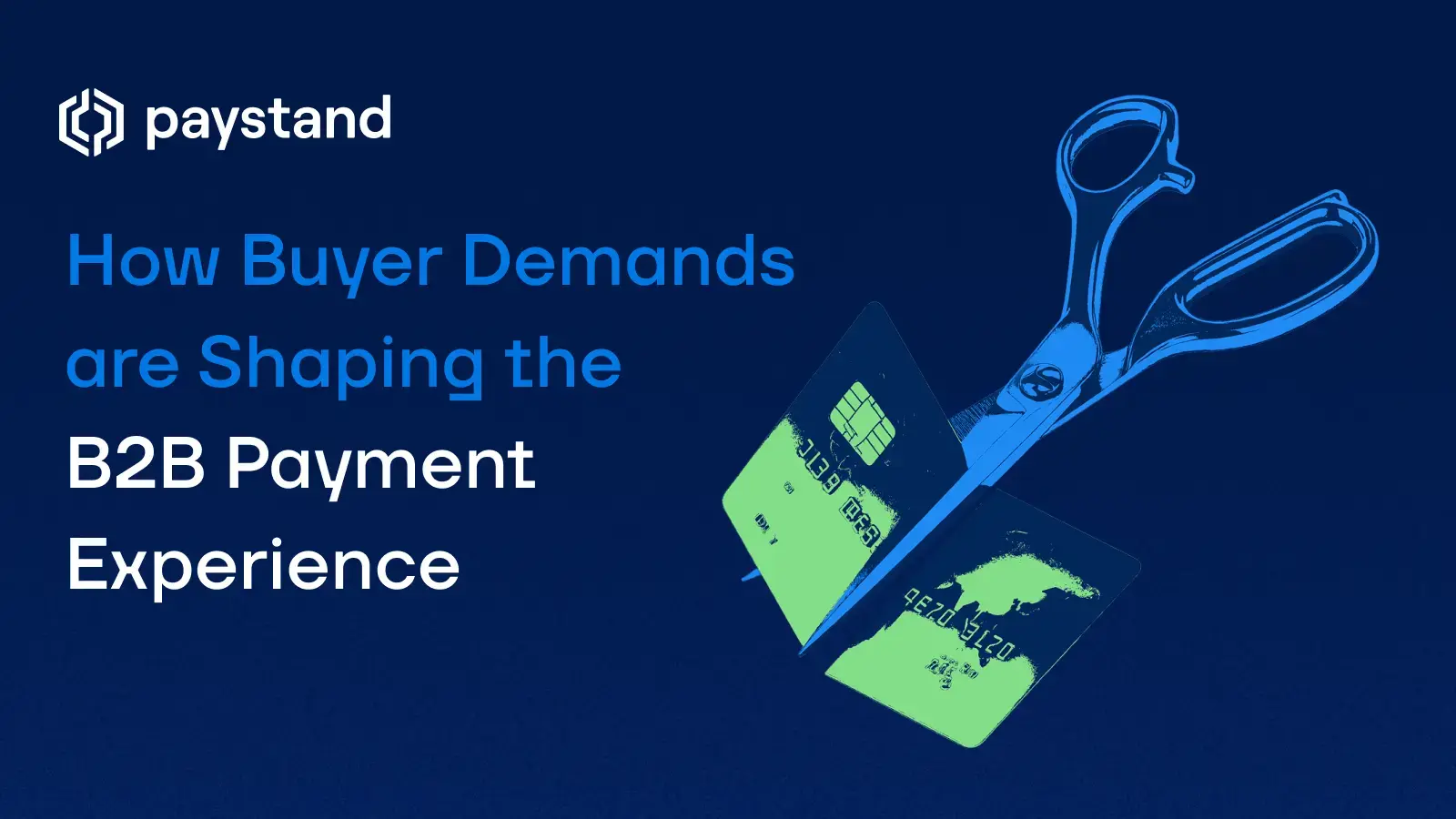How Buyer Demands are Shaping the B2B Payment Experience

- Introduction: The B2C vs. B2B Payment Gap
- How are B2B buyers expecting their B2B payment experience to mirror B2C?
- What digital self-service features do B2B buyers value most?
- How fast should credit and payment decisions be delivered?
- How are Gen Z expectations reshaping B2B payments?
- The Cost of Not Evolving
- What must B2B sellers do to meet buyer demands?
- Conclusion: Time to Close the Experience Gap
Key Takeaways
- Today’s buyers expect B2B payments to match the speed, transparency, and ease of consumer platforms like Amazon and Venmo.
- Self-service features — portals, pay-now links, and flexible options — are no longer optional. They’re table stakes for retaining customers.
- Sellers who cling to manual processes risk slow payments, lost deals, and weaker buyer loyalty.
- Modernizing the B2B payment experience closes the gap, accelerates cash flow, and positions businesses as forward-looking leaders.
The B2C vs. B2B Payment Gap
Picture this: you’re checking out on Amazon. One click, and your order is on its way. Or maybe you’re splitting a dinner bill on Venmo. Tap a button, payment sent, instant confirmation. Fast. Transparent. Effortless. That’s the kind of seamless interaction buyers now expect in every transaction, and it sets the standard for the modern B2B payment experience.
But now step into the world of B2B. That same person, your customer, tries to pay a supplier. Instead of a one-click transaction, they’re met with PDFs, wire instructions, multiple approvals, and a waiting game that can stretch for days.
This gap defines today’s B2B payment experience… and buyers don’t leave their expectations behind at the office. They want the same speed, flexibility, and convenience in their professional transactions that they enjoy in their personal lives.
Sellers who fail to meet that standard aren’t just creating friction — they’re risking revenue, relationships, and relevance.
How Are B2B Buyers Expecting Their B2B Payment Experience to Mirror B2C?
It’s no mystery why expectations are shifting. If buyers can track packages in real time, split a dinner tab instantly, and pay for groceries with a tap, why should paying a supplier feel like stepping back in time?
Despite these expectations, McKinsey shows that B2B payments still lag far behind consumer standards, with manual wires and outdated payment processing creating a frustrating disconnect.
Buyers want to know exactly when their payment went through, how much it cost, and that it was processed securely. Companies that still rely on manual wires, EFT, and PDFs are creating unnecessary friction in the very moment buyers are ready to pay.
The good news? Change is possible. Paystand’s perspective on building a frictionless B2B payment experience shows that closing the gap doesn’t just make buyers happier, it accelerates cash flow and positions businesses as modern, responsive partners.
What Digital Self-Service Features Do B2B Buyers Value Most?
Just like consumer checkouts, paying a bill online today is simple: log in, click, confirm. Buyers expect that experience at work, too, but many companies still make them jump through hoops.
According to Deloitte/WSJ research, 78% of B2B leaders say their customers are demanding more digitized sales processes, and failure to deliver puts revenue at risk. Self-service isn’t a perk anymore; it’s table stakes.
What does that look like in practice?
- Always-on portals where buyers can see invoices, track payment history, and manage terms without calling a rep.
- Pay-now links in invoices or emails for one-click payment.
- Flexible options: ACH payments, cards, or digital wallets.
The benefits aren’t one-sided. Buyers gain speed and flexibility; sellers gain faster payments, fewer back-office bottlenecks, and improved cash flow. Paystand’s guide to optimizing the customer payment experience demonstrates how embedded pay-now buttons, automation, and the right payment gateway tools help finance teams shed manual tasks while creating a better buyer experience.
How Fast Should Credit and Payment Decisions be Delivered?
Think about the last time you applied for a store credit card or tapped “buy now, pay later” on a retail site. The decision came back almost instantly, right? That expectation doesn’t vanish when buyers switch hats from consumer to business.
According to Hokodo, 83% of B2B buyers expect credit decisions within a single day, 22% want them in under an hour, and 19% expect them instantly.
If shoppers can apply for credit at checkout and get approved on the spot, why should a CFO or procurement manager be forced to sit through a drawn-out approval process for a B2B payment? Modern infrastructure makes instant or near-instant approvals possible, helping businesses keep deals moving instead of stalling in finance.
Paystand’s perspective on one-button transactions, outlined in Click Here to Pay This Invoice, shows how automation and a seamless ACH payment method can cut out delays. Whether it’s ACH, credit card payment processing, or other digital rails, faster approvals mean faster cash flow… and fewer frustrated buyers.
How are Gen Z Expectations Reshaping B2B Payments?
A new generation of decision-makers is entering the workforce, and they’re bringing their consumer habits with them. Gen Z grew up with smartphones, mobile wallets, and instant transfers. For them, speed, transparency, and purpose aren’t perks; they’re non-negotiables.
PaymentsDive puts it this way: “For Gen Z, payments go beyond speed — they reflect values, transparency, and purpose.”
Supporting data from The Financial Revolution shows that 53% of Gen Z want faster or instant payments, and 80% say mobile payment options are important.
This matters because Gen Z buyers aren’t comparing you to your competitors; they’re comparing your B2B payment experience to the consumer apps they use daily. If a supplier’s checkout feels clunky compared to Apple Pay or Google Wallet, that supplier risks being seen as outdated — and replaceable.
Paystand’s insights on payment security reinforce this point: younger buyers expect digital payment methods that are not only fast but also transparent and secure. Meeting these expectations builds loyalty and positions your company as future-ready.
The Cost of Not Evolving
It’s tempting to think a system is “good enough,” but that comes with real costs.
- Friction = late payments: McKinsey’s Global Payments Report 2023 shows that B2B transactions remain among the slowest in commerce, forcing finance teams to chase down receivables.
- Lost deals: Deloitte/WSJ research found that 78% of B2B leaders say customers demand digitized processes, and companies that don’t adapt risk losing business.
- Weaker loyalty: Buyers expect speed, transparency, and flexible B2B payment processing. If you can’t deliver, they’ll find a partner who can.
- Operational drag: Paystand’s billing cycle strategies show how outdated cycles drain productivity, leaving teams stuck in manual tasks instead of focusing on growth.
Clinging to legacy systems isn’t just inefficient; it’s a competitive liability. In a world where digital and EFT payments are evolving quickly, failing to evolve means falling behind.
What Must B2B Sellers Do to Meet Buyer Demands for Flexibility, Automation, and Transparency?
The path forward is clear: modernize payments infrastructure to deliver the experience buyers already expect. That means:
- Automating key tasks: Approvals, invoice reminders, and reconciliation can all be streamlined to speed payments and reduce errors.
- Offering flexible methods: Options like ACH payments, cards, digital wallets, and installments reduce friction and meet buyers where they are.
- Reducing hidden costs: Legacy systems pile on expenses like credit card processing fees. Modern platforms eliminate these costs and free up capital.
- Prioritizing transparency: Buyers expect full visibility into transactions, just like they get in consumer checkouts.
Paystand’s finance workflow automation guide shows how CFOs and finance leaders can embrace automation and digital-first tools to create a smarter, faster, and more transparent payment journey.
Time to Close the Experience Gap
Buyers don’t compare your checkout to your competitors anymore. They compare it to Amazon, Venmo, and Apple Pay. And if your B2B payment experience doesn’t measure up, you risk slower payments, strained relationships, and lost opportunities.
Sellers who modernize gain speed, loyalty, and cash flow, freeing teams to focus on strategy instead of chasing payments. The time to close the gap is now.
Do not wait until friction costs you your next deal. Explore Paystand’s free resources for deeper insights into modern payment strategies:







